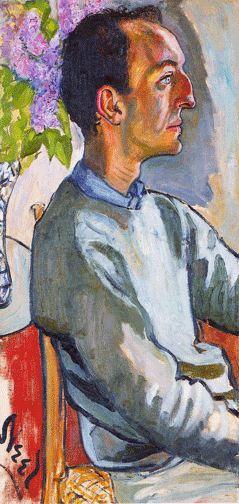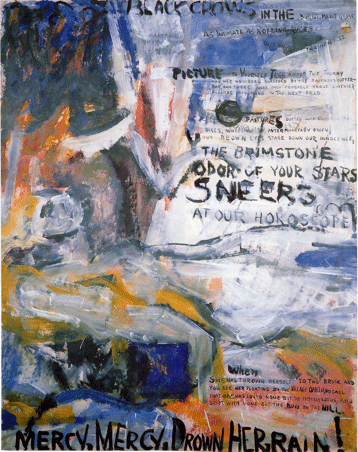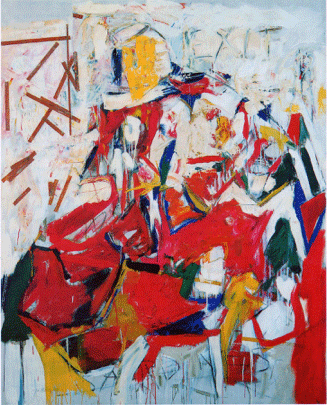In the past few years two new books have come out specifically related to art museums and their guards. All the Beauty in the World was written by Patrick Bringley, a long time guard at the Metropolitan Museum of art. The second was the exhibition and its catalogue that had been written and curated by a group of guards at the Baltimore Museum of Art, literally titled Guarding the Art. Providing both insider and intimate views of these great collections, we are given a deeper understanding of these works, not always available to the average visitor.
In later years, Grace Hartigan, Raoul Middleman, and Clyfford Still all had migrated from New York to Baltimore. The first critical responses to these moves were not positive, like moving totally out of the ‘art world’ of New York and becoming anonymous. However, they each found a new home in Baltimore and its own community of artists. And the Baltimore Museum of Art has an especially good selection of Hartigan’s work.

“Interior, ‘The Creeks’”
1957
Oil on canvas
90 7/16” x 96 1/4”
The Baltimore Museum of Art, Baltimore, Maryland
Describing Grace Hartigan’s work, Rob Kempton wrote: “As your eyes move around the canvas, something new and unknowable appears and pulls you in, never releasing its grip. . . .When Hartigan moved from New York City to Long Island in 1957, author Mary Gabriel noted Hartigan ‘returned to pure abstraction.’ In her new home, she sought to learn more from herself and nature, so this work feels personal and charged. As Hartigan built her canvas with paint, she juxtaposed bold opaque colors against thin translucent washes to create tension—a push-pull feeling. Here, instinct and energy merge through brilliant palette knife scraping and confident brushstrokes.”1
Hale Woodruff, who studied from 1920 to 1924 at the John Herron Art Institute in Indianapolis (later known as the Herron School of Art), established himself as a mature artist in both Washington, D.C., and New York City. We actually met when he received an honor for his work here in Indianapolis in the mid-seventies. And Mr. Woodruff’s work was especially featured at the opening of the National African American Museum in Washington, D.C.
Guard Kellen Johnson made this observation: “Following World War I (1914-1918), many Americans found it very difficult to find work at home and oftentimes had to relocate to Europe to find their fame and fortune.”
“Hale Woodruff captured this rustic scenery in a traditionally horizontal landscape format, though his modernist approach is still prevalent. The painting is mostly characterized by its vigorous brushstrokes, with green willow trees in the foreground distinctly orchestrated into their own strongly rhythmic pattern. In 1928, Woodruff won third place in the short-lived William E. Harrison Foundation Awards for Distinguished Achievement Among Negroes. He used the hundred-dollar prize to book a one-way ticket to finish his art studies in Paris; Normandy Landscape was painted during this trip.”2

“Normandy Landscape”
1928
Oil on canvas
21 1/4” x 25 5/8”
The Baltimore Museum of Art, Baltimore, Maryland
I first became aware of Sam Gilliam’s work at one of the smaller galleries inside the Phillips Collection in Washington, D.C. The Phillips always reserved one small gallery up on the third floor for local artists, especially the Washington School of Color Painters. It was there that I first saw the work of Morris Louis, Kenneth Nolan, and the younger artist, Sam Gilliam.
Responding to Gilliam’s painting, Dominic Mallari wrote: “Bursts of color, rings of noise, and the sound of music emanate from Blue Edge. Sam Gilliam speaks highly of his jazz influences, and so do his works of art. Gilliam moved to Washington, D.C., during the 1960s Civil Rights Movement. It is there where he produced many of his paintings. While in D.C., he listened to celebrated jazz musicians such as saxophonist John Coltrane and pianist Thelonious Monk, which pushed his painting style higher and higher. Blue Edge is a premier example of such works. . . .When I look at this painting, I imagine a melodic mess, like hearing the instrumental ballets of musicians. Each stroke of color fights to take center stage. The painting is powerful yet somehow contained, waiting to be seen and heard; always a masterpiece. Hang in there, take it in, and mind the edge.”3

“Blue Edge”
1971
Acrylic on canvas
71 7/8” x 71 3/4”
The Baltimore Museum of Art
Traveling north from Baltimore to New York City we are shown the daily life of another museum guard, Mr. Patrick Bringley, at the Metropolitan Museum of Art. Bringley chronicles his experiences from his initial orientation and his first tours of duty to final reflections on his career. From local Americana selections to the great masterpieces of European art, his words strike true to this important collection and its mission.
“Looking at Bruegel’s masterpiece I sometimes think: here is a painting of literally the most commonplace thing on earth. Most people have been farmers. Most of these have been peasants. Most lives have been labor and hardship punctuated by rest and the enjoyment of others. It is a scene that must have been so familiar to Pieter Bruegel it took an effort to notice it. But he did notice it. And he situated this little, sacred, ragtag group at the fore of his vast, outspreading world.”
“I am sometimes not sure which is the more remarkable: that life lives up to great paintings, or that great paintings live up to life.”4

“The Harvesters”
1565
Oil on wood
46 7/8” x 63 3/4”
Metropolitan Museum of Art, New York
On his daily rounds throughout the museum, Bringley takes us in and out of the many hidden nooks and crannies of the building.
“Just below the main painting galleries, there is a mezzanine that is one of the strangest, most eclectic places in the whole museum. The ‘visible storage’ area houses tens of thousands of objects that haven’t found a place in the galleries proper. Without much signage, visitors navigate long narrow channels flanked by tall glass cases presenting a jumble of Americana from the past four hundred years. If you like tables, here are dining tables, tea tables, worktables, card tables, and chamber tables. If you favor clocks, it offers tall clocks, shelf clocks, wall clocks, acorn clocks, lighthouse clocks, banjo clocks, and lyre clocks. The mezzanine is the one area of the Met where visitors declare objects to be ‘just like the one Aunt Barb has.’ It’s a place to take a break from hallowed masterpieces and enjoy the company of looking glasses, sugar nippers, and firemen’s leather helmets and shields.”5

“Dining Table”
1800-1825
Pine, maple, and basswood
28 1/2” x 31 1/4” x 96 1/2”
Metropolitan Museum of Art, New York
So, hidden away in all of this attic-like assembly is a beautifully simple Shaker Dining Table. Unadorned, spiritual. And, if we were to return to the painting galleries upstairs, especially the 20th Century American galleries, we might discover Charles Sheeler’s interior “Americana” from 1931, that contains this very table in use in his own home and the subject of this painting.

“Americana”
1931
Oil on canvas
48” x 36”
Metropolitan Museum of Art, New York
1 Sims, Lowery Stokes, Hakim Bishara, et al; Guarding the Art; The Baltimore Museum; Baltimore, Maryland; 2022; p. 70.
2 Sims, Lowery Stokes, Hakim Bishara, et al; Guarding the Art; The Baltimore Museum; Baltimore, Maryland; 2022; p. 64.
3 Sims, Lowery Stokes, Hakim Bishara, et al; Guarding the Art; The Baltimore Museum; Baltimore, Maryland; 2022; p. 82.
4 Bringley, Patrick; All the Beauty in the World: The Metropolitan Museum of Art and Me; Simon & Schuster; New York, New York; 2023; p. 87-88.
5 Bringley, Patrick; All the Beauty in the World: The Metropolitan Museum of Art and Me; Simon & Schuster; New York, New York; 2023; p. 129.


